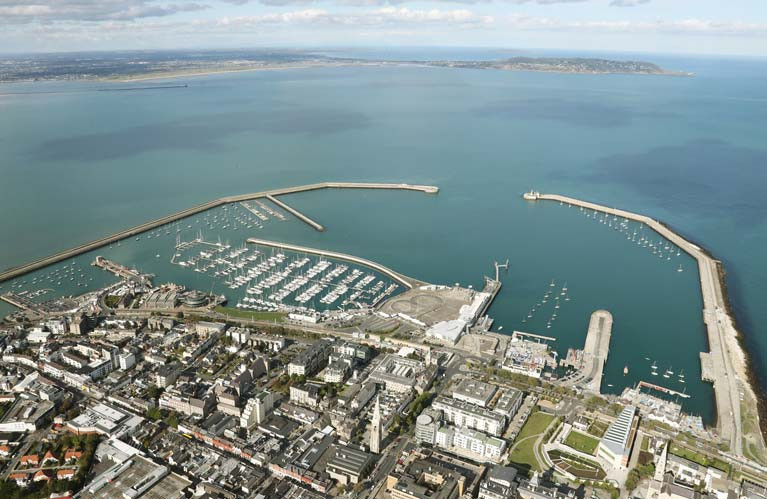Dun Laoghaire is undoubtedly a harbour which merits study. So much so, in fact, that as of this week, the qualifications for detailed study of the magnificent artificial harbour and the remarkable town beside it have been quantified - to the cool tune of €600,000 in all -for research and report on development.
It’s a tidy sum. Yet it’s real enough. Back in September, we referred to the two analyses which Dun Laoghaire Rathdown County Council had put out to tender for €100,000 each, one for research and conclusions on how best to develop the harbour/township waterfront area, and the other – for an identical amount – for recommendations on putting new life into the rundown parts of the town itself.
The harbour and the coastal location being Dun Laoghaire’s greatest assets, with the harbour the township’s ultimate reason for existence despite the fact that the original harbour planners didn’t take the creation of a township into account, we’d have thought the two projects were the two sides of the same coin. But even with them being separate contracts, the fact is that by the end of 2019, €200,000 had set aside for these specific expenditures, and the research work was underway.
But as of this week, those two smaller studies have been put in the shade by the very clear announcement by the Department of Transport, Tourism & and Sport that a feasibility study - costed at €400,000 - will be Government-commissioned to progress the €8 million National Watersports Campus proposed for the harbour by Dun Laoghaire Rathdown County Council, working in concert with Irish Sailing and the Irish Underwater Council, and supported specifically by Triathlon Ireland, Rowing Ireland, Irish National Sailing & Powerboat School and Canoeing Ireland, with additional support from nearly 40 other organisations – including the yacht clubs - which use the harbour and its environs in one way or another.
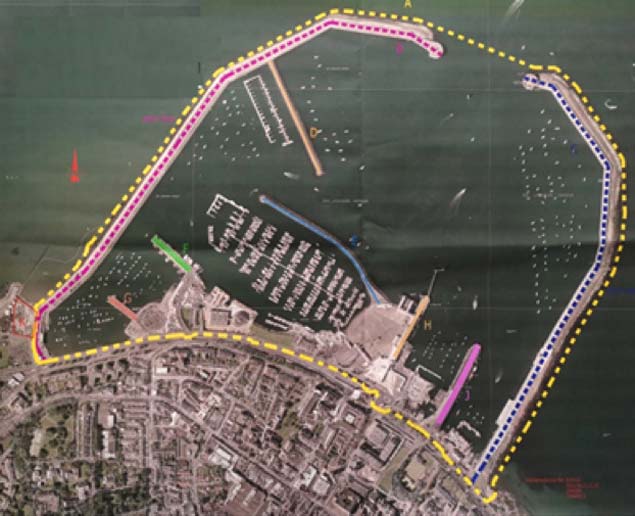 The proposed National Watersports Campus is envisaged as being the entire area within the yellow-dotted line, including all the waterfront shoreside area to seaward of the railway line.
The proposed National Watersports Campus is envisaged as being the entire area within the yellow-dotted line, including all the waterfront shoreside area to seaward of the railway line.
Getting so many different organisations and interests to pull together and work in support of what is ultimately a Local Government initiative has been a monumental task of patience and persistence, and painstaking attention to detail. For in the end, the fact that the Dun Laoghaire proposal was one of the few that won out, in what was effectively a national competition involving many possible projects applying to the Large Scale Sports Infrastructure Fund (LSSIF), was a matter of covering every angle from the effect on the local economy – particularly employment – to the environmental impact, while working in with the fact that anything which makes participant sport more accessible and welcoming chimes well with national policy on improving people’s health and sense of wellbeing.
The proposed National Watersports Campus will also play a key role in bringing much more life to the Dun Laoghaire waterfront, as it would be expected to function on a seven days a week basis, certainly from March to November, and probably year-round. And once you start getting such activity being the norm at one of the most visible parts of the harbour (for the already busy Irish National Sailing School is somewhat hidden away in the inner recesses of the Coal Harbour to the westward) the perceptions of the harbour as a place only of seasonal activity and vitality will change, and the sometimes weak interaction between town and sea will become more dynamic.
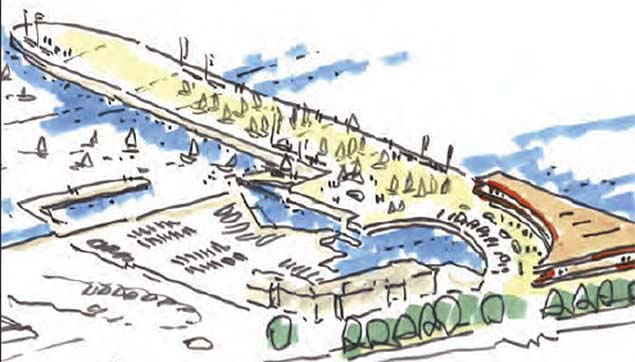 A preliminary artist’s sketch of the possible layout for the National Watersports Centre at the south end of the Carlisle Pier, with a large-scale all-tides slipway on the pier’s west side
A preliminary artist’s sketch of the possible layout for the National Watersports Centre at the south end of the Carlisle Pier, with a large-scale all-tides slipway on the pier’s west side
But all these things would not have become possible as of Monday this week had it not been for a long period of what might be called good work by stealth by a visionary group. Good work by stealth is perhaps the only truly good work, except that “stealth” suggests subterfuge, whereas this has all been about many hours and days – years even – of discussion, planning and quiet meetings and then yet more meetings, always through official channels but without making a song and dance about it.
From time to time here in Afloat.ie we’ve alluded to the proposed developments gradually taking shape, but have tried to respect the fact that those involved are doers rather than talkers, except when talk is needed to progress the project. Thus we’re in the odd position of mentioning all the main organisations which are involved without mentioning any single person’s name, and that is the way that those who got this particular ball rolling would like it, for until the official announcement was finally made, nothing was absolutely certain.
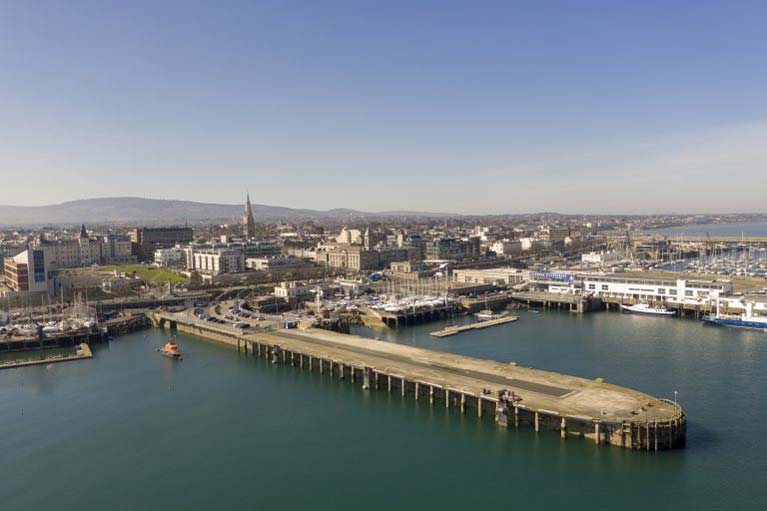 Carlisle Pier is in a sorry state, its outer end in the heart of the harbour inaccessible, and the inner end utilised as a car park. Photo courtesy Barrow Coakley/Simon Coate
Carlisle Pier is in a sorry state, its outer end in the heart of the harbour inaccessible, and the inner end utilised as a car park. Photo courtesy Barrow Coakley/Simon Coate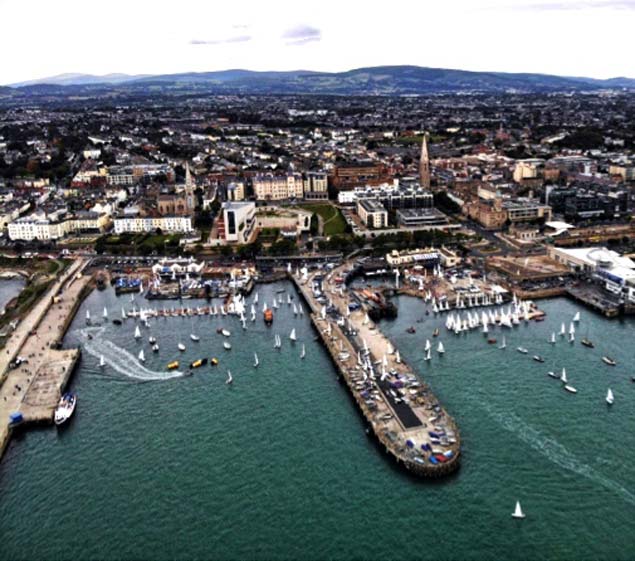 Carlisle Pier brought temporarily to life for the Laser World Masters, September 2018. Planning for the new National Watersports Centre was able to draw on experienced gained from this event in which more than 300 boats took part
Carlisle Pier brought temporarily to life for the Laser World Masters, September 2018. Planning for the new National Watersports Centre was able to draw on experienced gained from this event in which more than 300 boats took part
Maybe the sudden imminence of a General Election had something to do with this week’s surprise revelation of good news. Whatever, it certainly brightened up a Monday morning in January to learn that we were having one of those rare experiences when boat users of all kinds - and harbour users of every sort in Dun Laoghaire - seemed to be on the right side of politics, and of history too.
For talk of “history” is not over-stating it. The final shape of Dun Laoghaire’s extraordinary artificial harbour – so monumental that people think of it as a natural feature of Dublin Bay – was not finalised until the 1820s, even though construction had been started in 1817. But once it had been finalised, that was it – the outer limits of the great harbour had been set, and have remained the same ever since.
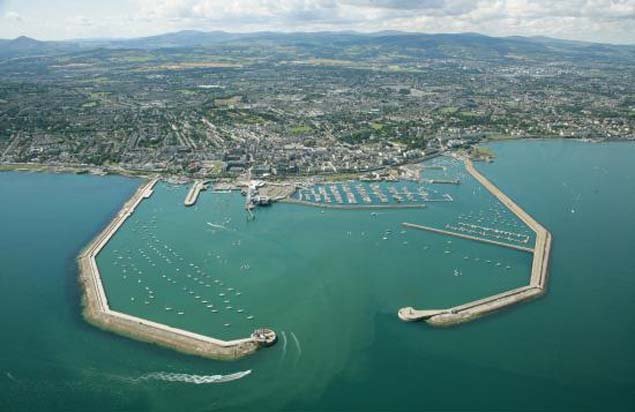 Set in stone. Any plans for modern facilities in Dun Laoghaire Harbour have to take account of the fact that the basic outer shape was unchangeably set 200 years ago. Photo Peter Barrow
Set in stone. Any plans for modern facilities in Dun Laoghaire Harbour have to take account of the fact that the basic outer shape was unchangeably set 200 years ago. Photo Peter Barrow
But within, there has been scope for development, and it has not always had happy results. The weakened state of the Irish economy in the 1950s meant that some cheap ad hoc arrangements had to be put in place to accommodate the growing size of cross-channel ferries. And as the ferries were the harbour’s main source of income, their needs became paramount, leading to the construction of the massive yet decidedly incongruous Ferry Terminal on the extensive St Michael’s Wharf site in the prime site in the middle of the waterfront, dwarfing everything else.
So too did the huge HSS ferries which it served. Yet while the ferries and the terminal may have grown, the narrow winding roads ashore stayed the same, with the increasing size of juggernaut trucks which the ferries brought in leading to traffic congestion and pollution. “Dun Lorry No Thanks” became the catch-phrase of early environmentalists in the late 1990s, yet it was harsh economics as much as environmental concerns which led to the final ferry sailing in 2015.
This meant that the Dun Laoghaire waterfront – where every inch of space should be regarded as valuable with potential positive uses – now had two former ferry terminals of substantial area in Carlisle Pier and St Michael’s Wharf, locations which were basically dead spaces, even if their quaysides provided berths for the occasional ship and large yachts.
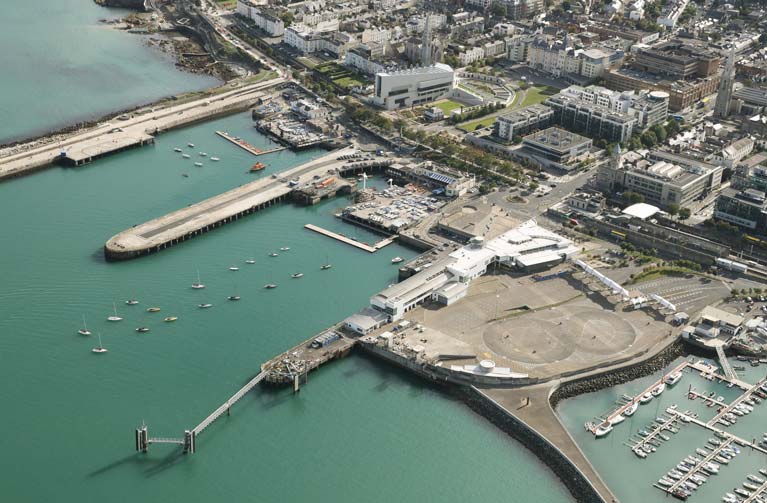 The eastern part of the Dun Laoghaire waterfront is blighted by the “dead spaces” of former ferry terminals at St Michael’s Wharf (foreground) and Carlisle Pier beyond.
The eastern part of the Dun Laoghaire waterfront is blighted by the “dead spaces” of former ferry terminals at St Michael’s Wharf (foreground) and Carlisle Pier beyond.
The utter lifelessness of these spaces has been emphasized by the fact that they are set between compact areas of intense maritime activity. To the eastward of Carlisle Pier is the busy National Yacht Club and the Dun Laoghaire RNLI base. Between Carlisle and St Michael’s, the Royal St George YC clubhouse with its forecourt/pontoons complex buzzes with life. Westward of the St Michael’s desert, the Marina and the Royal Irish YC snugly within it offer one of the best boat-berthing prospects in Europe.
Westward of the RIYC is the brief but welcome and revitalising waterfront of the Green, a very precious space. Beyond that, there is the Irish Lights HQ, and within it Irish Sailing’s Performance Group’s base – a temporary but vital facility which apparently will find a permanent home with the new National Watersports Centre.
Furthest west of all is the Coal Harbour, the Inner Harbour - call it what you will, and some would like to see it become more of a Heritage Harbour within the main harbour. But at the moment it’s an area where MGM Boats, St Michael’s Rowing Club, the Irish National Sailing School, Dun Laoghaire Motor Yacht Club and other organisations are making visionary and successful use of spaces which the original designers of the harbour left behind as by-products of their very fixed grand design two hundred years ago.
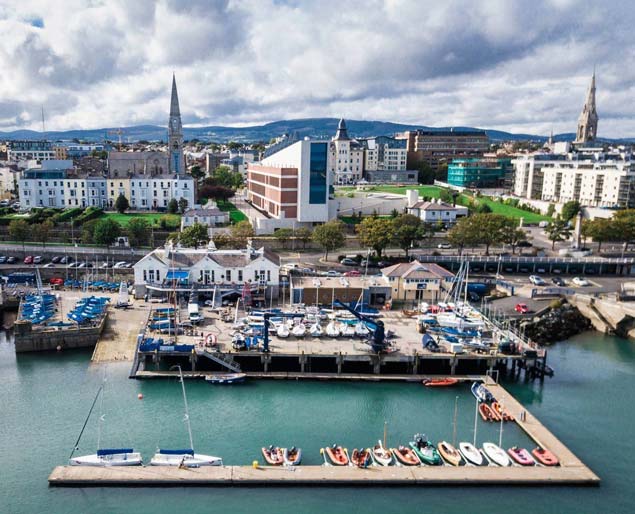 A welcome focus of vitality – the well-maintained National YC is the most easterly of Dun Laoghaire’s waterfront yacht clubs and is celebrating its 150th anniversary in 2020
A welcome focus of vitality – the well-maintained National YC is the most easterly of Dun Laoghaire’s waterfront yacht clubs and is celebrating its 150th anniversary in 2020
Now, with the Council itself taking over the harbour and the harbour offices being re-located into County Hall, a new spirit of shared purpose has been gradually building as people recover from the prospect of the harbour being forced into domination by polluting cruise-liner berths in pursuit of what seemed like easy money and very questionable benefits. At last, there is a real sense of people, groups and organisations pulling together in order to see how best this extraordinary asset can be maximised for everyone’s benefit in many ways, with a healthy environment a top priority while at the same time retaining the harbour’s unique character.
It’s surely not overstating the case to suggest that the continuing success of the biennial Volvo Dun Laoghaire Regatta since its inception in 2005 has played a key role in developing this spirit of co-operation. It may seem absurd nowadays to think that it all seemed very novel at the time, but in those days the clubs all did things their own way, they relied on Dublin Bay Sailing Club to co-ordinate their weekly racing programme, and every year each club gave expression to its individuality with its own standalone regatta.
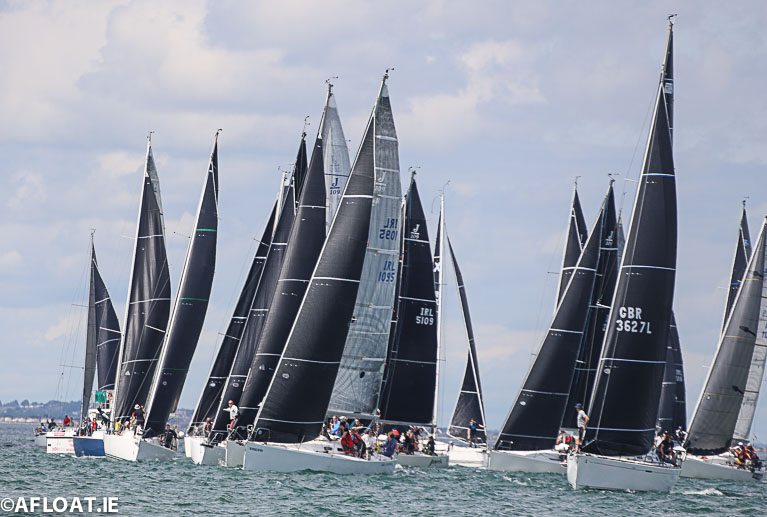 Volvo Dun Laoghaire Regatta in Dublin Bay. For fifteen years, this successful biennial event, the outcome of combined effort, has contributed greatly to the growing readiness of different organisations and the Council to work together in developing the harbour’s potential. Photo: Afloat.ie/David O’Brien
Volvo Dun Laoghaire Regatta in Dublin Bay. For fifteen years, this successful biennial event, the outcome of combined effort, has contributed greatly to the growing readiness of different organisations and the Council to work together in developing the harbour’s potential. Photo: Afloat.ie/David O’Brien
Certainly, there’d been attempts at regatta weeks in times past, but they’d always had the flavour of being one-offs. What was needed was a shared inter-club organisation which was in it for the long haul, and that came into being fifteen years ago, and has been going from strength to strength ever since, with the Council increasingly involved.
Then there was the shared emotion when Annalise Murphy of the National Yacht Club came home with her Olympic Silver Medal from Rio in August 2016. An Olympic medal is an Olympic medal regardless of whether or not one understands the ins and outs of the sport involved, and the magic day and night of Annalise’s return played its part in the slow process of changing perceptions of the relationship between town and harbour.
Yet if anything that changing perception emphasised the harbour’s general lack of convenient accessibility. At its most basic level, the prime location for simply viewing in-harbour activity would be from an observation area on the seaward side of the St Michael’s Wharf former ferry terminal and marshalling yard area. But it’s completely a no-go area.
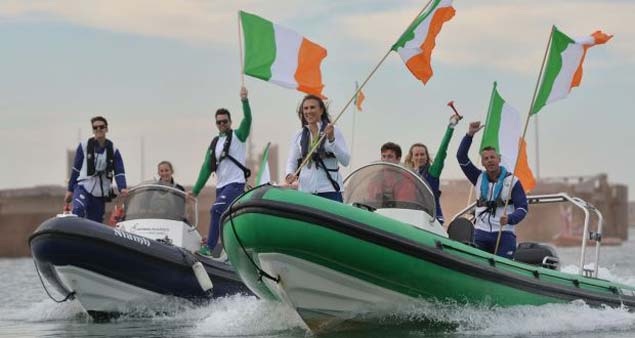 The conquering hero – Annalise Murphy returns to Dun Laoghaire with her Olympic Medal in 2016
The conquering hero – Annalise Murphy returns to Dun Laoghaire with her Olympic Medal in 2016
So too is the outer end of Carisle Pier. Certainly, you can stroll down the East Pier if you want to see the in-harbour activity, and there are reportedly 1.25 millions such strolls every year, though the majority are probably regular repeats. But for land-bound observers, there’s nothing to match being on the end of a pier within a busy harbour at a time of maximum activity afloat, and the fact that the end of Carlisle Pier is currently deemed unsafe is too typical of the way things had been going.
As for the inner sound section of Carlisle Pier’s use as a car park, it was convenient, it generates an income stream, but harbours are meant at the very least to be boat parks, not car parks, and in the case of Dun Laoghaire with its unrivalled areas of sheltered in-harbour sailing and boating water, a more meaningful boat-oriented use was needed for Carlisle Pier.
And that is going to be as the location for the new National Watersports Centre. The proposal is that all of Dun Laoghaire Harbour should be designated as the National Watersports Campus - an umbrella sort of description which can be interpreted in many ways – while the more specific focus for the Centre itself will be a new building on the inner end of Carlisle Pier beside storage parks for smaller boats of every kind, and with a king-size all tide slipway on the pier’s west side.
In terms of the way Dun Laoghaire might have gone astray, this complete concept is very definitely a major breakthrough in the right direction, not least in that its recognized permanence will bring with it lasting jobs which won’t leave Dun Laoghaire, jobs in the centre itself and supporting jobs in the many small businesses which will cluster around it.
For as one sage observer of the marine scene put it this week, however large scale Dun Laoghaire harbour itself may seem, the reality is that its waterfront and adjacent area is the function zone for many enterprises which, when rated by the number of people employed, are small businesses in the national sense of the term.
The yacht clubs, despite their grand histories with the National Yacht Club celebrating 150 years this year, are small businesses. Irish Lights may play a major role on the entire Irish coast, but when its total workforce is set against the thousands employed in the burgeoning tech industries elsewhere in Ireland, it is definitely a small business. As too is the marina, and the harbour itself if we separate its staff within their new Council environment.
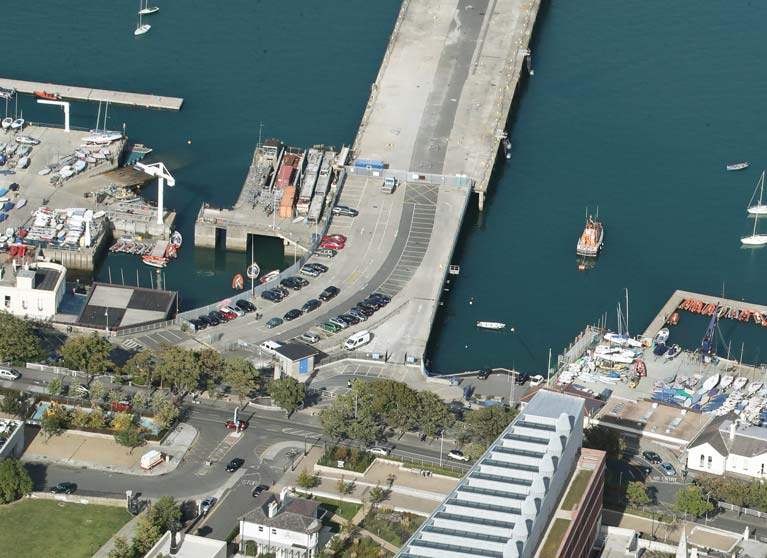 The proposed site for the location of the National Watersports Centre will transform the immediate harbour area. Photo: Barrow Coakley/Simon Coate
The proposed site for the location of the National Watersports Centre will transform the immediate harbour area. Photo: Barrow Coakley/Simon Coate
All these employees around the harbour are small businesses, yet between them they are a vital and significant part of the Dun Laoghaire economy, and the creation of the National Watersports Centre at the Carlisle Pier will be of primary importance in realising Dun Laoghaire true potential as an important part of building a healthier national lifestyle as we go through the 21st Century, while securing the future of existing and new small businesses.
That said, the transformation of Carlisle Pier is only the beginning – albeit an extremely welcome one - of the process of bringing new life to the “dead spaces” of Dun Laoghaire’s waterfront. But the complex discussion of what might happen to the spacious St Michael’s Wharf site with its former Ferry Terminal building is something for another day. For now, the go-ahead for the Feasibility Study and new life for Carlisle Pier is more than enough for the weekend.




























